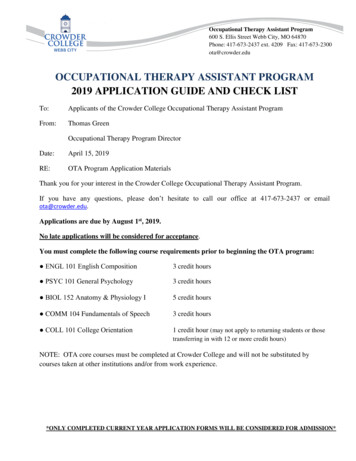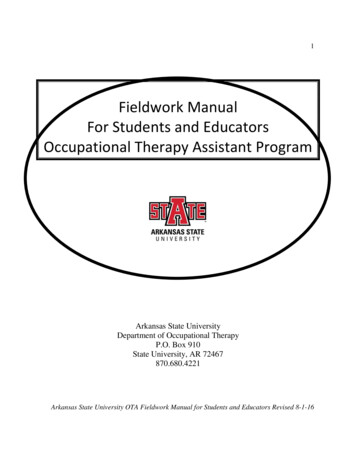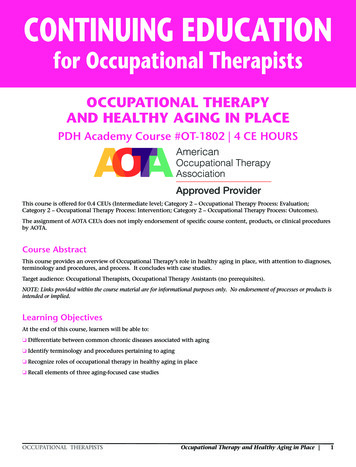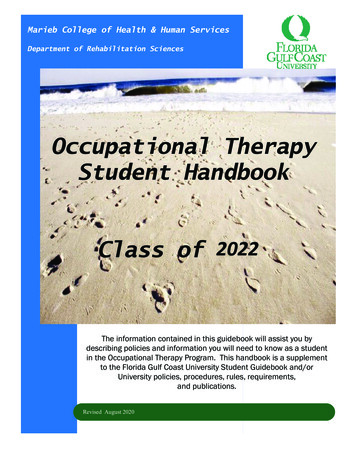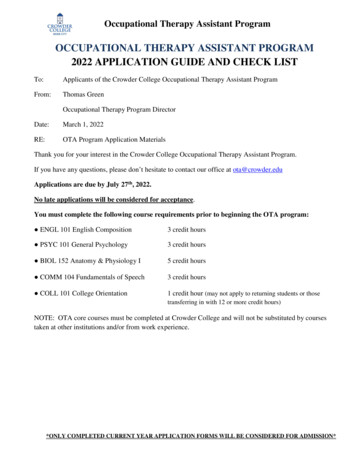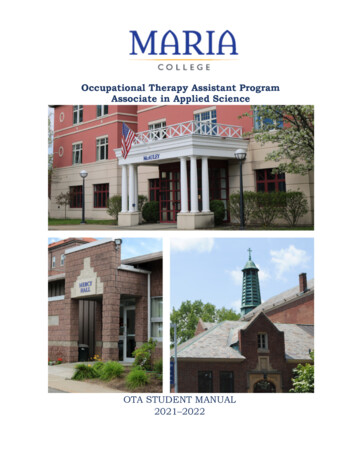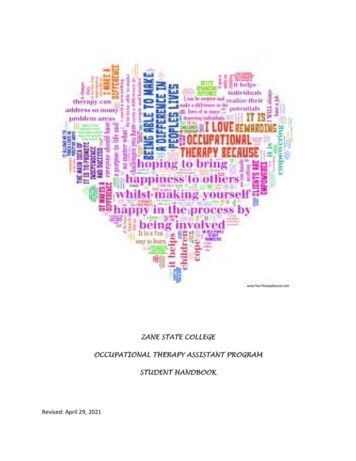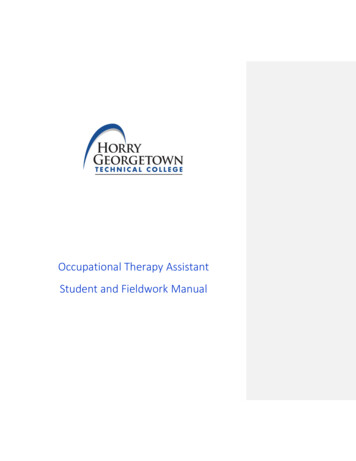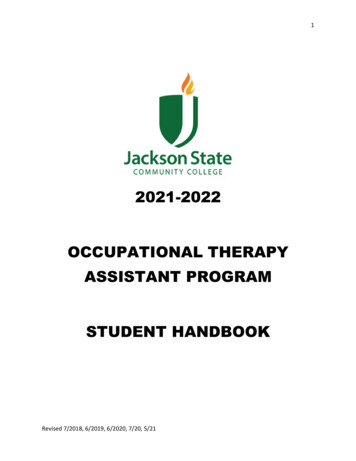
Transcription
12021-2022OCCUPATIONAL THERAPYASSISTANT PROGRAMSTUDENT HANDBOOKRevised 7/2018, 6/2019, 6/2020, 7/20, 5/21
2JACKSON STATE COMMUNITY COLLEGE (JSCC)OCCUPATIONAL THERAPY ASSISTANT STUDENT HANDBOOKTABLE OF CONTENTSWelcomeSection IFoundational StatementsHistorical OverviewAccreditationMissionVisonPhilosophySection IICurriculumCurriculum DesignContent SequenceFieldworkSection III Admission PoliciesProgram OrganizationImportant Telephone NumbersOTA Advising/Student Professional Behavior CompetenceOTA Advisory CommitteeAdmissionSection IVStudent PoliciesClassroom Dress and Behavior PolicyProfessional Behavior and Classroom StandardsCell Phone UseRetention PolicyProgram Retention 2 yearProgram Retention –approved 3 yearCourse Failure PolicyProgram ProbationGrievance/Appeal ProcedureTransfer PolicyPrior Work ExperienceProgram WithdrawalReadmissionAttendanceObjective Assessment Testing PolicyLaboratory Testing and AssessmentInfection control and SafetyFieldwork AttendanceStudent Disability ServicesFees and Dues/Criminal Background Check/Health RequirementsFinancial Aid/Textbooks/Insurance PolicyRevised 7/2018, 6/2019, 6/2020, 7/20, 5/21Pg. 4Pg. 5Pg. 6-7Pg. 8Pg. 9Pg. 9Pg 10-11Pg.12-13Pg. 14-22Pg. 23-24Pg. 25Pg. 26Pg. 27Pg. 28Pg. 29Pg. 30Pg. 31Pg. 32Pg. 33Pg. 34Pg. 35Pg. 36Pg. 37Pg. 38Pg. 39Pg. 40Pg. 41Pg. 42Pg. 43Pg. 44Pg. 45Pg. 46-47Pg. 48-49Pg. 50-51Pg. 51-54Pg. 54-56Pg. 57Pg. 58
3Preparing for GraduationCertificate Preparation/State Licensure/Placement ServicesLibrary/Writing CenterProgram EvaluationProfessional Development Opportunities and MembershipsPg. 59Pg. 60-61Pg. 62Pg. 63Pg. 64-69Section VAppendixCurriculumCourse DescriptionsAcademic and Classroom MisconductDisciplinary Written WarningWritten ReprimandNotification of ProbationAcademic Course Failure NoticeCompetence Document Professional BehaviorsCompetence Document Therapeutic InteractionsLifelong LearningLecture Note Taking AdviceTextbook Annotation HintsAOTA Student ResourcesConsent to Drug and Alcohol TestingRelease of LiabilityStatement of Acknowledgement and UnderstandingStatement of Acknowledgement and Understanding: HIPAA and Social MediaOTA Program ContractPg. 70Revised 7/2018, 6/2019, 6/2020, 7/20, 5/21Pg. 71-73Pg. 74Pg. 75Pg. 76Pg. 77Pg. 78Pg. 79Pg. 80Pg. 83Pg. 84Pg. 86Pg. 88Pg. 92Pg. 93Pg. 94Pg. 95-96Pg. 97-100
4Welcome!Congratulations on your admittance into the Occupational Therapy Assistant Program at JacksonState Community College! We are excited that you have chosen Occupational Therapy as ahealth career and that you chose to have Jackson State Community College assist you with youreducation. Occupational Therapy is a rewarding and challenging field with diverse opportunities.You are entering a profession that has a strong heritage of assisting individuals reach theirgreatest participation in life activities. The aim of the Occupational Therapy Assistant Program isthat you progress successfully through the courses leading to your preparation as an entry-levelOccupational Therapy Assistant. The next two years will be exciting, demanding, and verygratifying. You will be expected to work hard as you study and learn about the profession ofOccupational Therapy. This will require a great deal of effort, commitment, and dedication toexcellence. We encourage and expect that you will be an active participant in this formallearning process that serves as the beginning of lifelong and continuous learning related to yourchosen profession. The faculty and staff are here to help you succeed. If you need assistance,seek out your faculty and college staff to advise and support you.The Occupational Therapy Assistant Program has developed a handbook to orient you to thepolicies, procedures and expectations of the program. You will want to reference the materialsincluded in this handbook throughout the program. This handbook does not replace the JacksonState Community College student handbook which can be found at www.jscc.edu, but serves asa guide. The information contained in both handbooks applies to the program. Please feel free tocontact the program director or your advisor for any questions you may have.I would like again to welcome you to the Occupational Therapy Assistant Program at JacksonState Community College.Best Wishes for your Success,Julie Bezold, OTD, OTR/LProgram Director731-424-3520 ex 50755jbezold@jscc.eduRevised 7/2018, 6/2019, 6/2020, 7/20, 5/21
5SECTION IFoundational StatementsRevised 7/2018, 6/2019, 6/2020, 7/20, 5/21
6HISTORICAL OVERVIEWIn 1963, the Tennessee General Assembly responded to recommendations made in the Pierce-AlbrightReport by establishing a group of state community colleges. Jackson State was selected as the first suchinstitution in West Tennessee.Jackson State Community College (JSCC) occupies a 97-acre main campus located in Jackson, Tennesseeand maintains three college centers in Humboldt, Lexington, and Savannah, Tennessee. The maincampus contains 80 acres of open land with wooded areas, a pond, performance area, and walkways.JSCC is accredited by the Southern Association of Colleges and Schools Commission on Colleges. It is apublic, nonresidential institution of higher education governed by the Tennessee Board of Regents ofthe State University and Community College System of Tennessee. Jackson State’s physical communityconsists of a 14-county service area in predominantly rural West Tennessee.Jackson State Community College began envisioning the Occupational Therapy Assistant Program in thefall of 1992, in response to community expression of need for certified occupational therapypractitioners. An advisory committee was formed consisting of Jackson State Community College (JSCC)faculty, administrators, healthcare practitioners, and occupational therapy practitioners within thecommunity. A feasibility assessment was created and sent out to facilities and practitioners in thesurrounding region to assess the need for the establishment of an occupational therapy assistantprogram at JSCC. In fall of 1994, an academic proposal was submitted to the Tennessee Board ofRegents (TBR) Based upon the positive results of the feasibility assessment. Approval from TBR wasreceived in 1995 to launch an OTA program at JSCC. Administration at the college worked diligently tosecure an OTA Program director with unsuccessful results. Approximately ten years later, the OTAprogram was again open for discussion. In 2005, a letter of intent was submitted to ACOTE; however, anOTA Program Director was unable to be hired. In 2013, another letter of intent was submitted to ACOTEwith a program director hired in the fall of 2014.JSCC began its self- study process in August of 2014 under the direction of OTA Program Director Dr.Julie Bezold. Dr. Bezold comes to JSCC with an in-depth history as a practitioner, manager, and businessowner. Dr. Bezold completed her degree as a Certified Occupational Therapy Assistant (COTA/L) in 1998from Penn State, Berks Campus. She worked in various healthcare settings as a COTA in Tennessee toinclude: long term care, pediatrics, mental health in the community, skilled nursing and out-patientrehabilitation. Dr. Bezold returned to The University of Tennessee Health Science Center to completeher Bachelors of Science in Occupational Therapy. In 2004, she co-founded an aquatic out-patientrehabilitation center known as AquaTherapies in Jackson, TN. In 2010, Dr. Bezold completed her PostProfessional Doctor of Occupational Therapy at Rocky Mountain University of Health Professions.In May 2015, Gwen Foxx, MA, COTA joined the OTA team at JSCC as the Academic FieldworkCoordinator. Gwen graduated with an Occupational Therapy Assistant Certificate in 1986 from NashvilleState Technical Institute. Ms. Foxx continued with her education to pursue a Bachelor of Science inHealth Administration in 2010 and a Masters of Arts in Teaching and Learning Technology. Gwen has anextensive work history in various settings to include skilled nursing, long term care, pediatrics, mentalRevised 7/2018, 6/2019, 6/2020, 7/20, 5/21
7health within the community, and consultant with the assistive technology efforts of 26 schools acrossShelby County, TN. In 2013, Gwen became the Academic Fieldwork Coordinator and Instructor forBrown Mackie College in Salina, KS. Gwen shares with the OTA Program’s vision to be recognized foracademic excellence, leadership, community employment, and graduating students who are committedto the delivery of quality services and professional development. JSCC will be the number one choice inour region for students to pursue their future career as an occupational therapy assistant.Dr. Bezold submitted the OTA candidacy application for developing program status on January 15, 2015to ACOTE. A decision from ACOTE was received in May 2015 which granted JSCC developing programstatus and the green-light to officially accept students into the OTA Program. In December 2015, Dr.Bezold submitted the OTA Program Self-Study and was granted Pre-accreditation status in April of 2016.Official Accreditation was granted for 7 years to the OTA program December 2016.Revised 7/2018, 6/2019, 6/2020, 7/20, 5/21
8Accreditation Information:The occupational therapy assistant program is accredited by the Accreditation Council forOccupational Therapy Education (ACOTE) of the American Occupational Therapy Association (AOTA),located at 4720 Montgomery Lane, Suite 200, Bethesda, MD 20814-3449. ACOTE’s telephone numberc/o AOTA is (301) 652-AOTA and its Web address is www.acoteonline.org. Graduates of the programwill be eligible to sit for the national certification examination for the occupational therapy assistantadministered by the National Board for Certification in Occupational Therapy (NBCOT). Aftersuccessful completion of this exam, the individual will be a Certified Occupational Therapy Assistant(COTA). In addition, all states require licensure in order to practice; however, state licenses are usuallybased on the results of the NBCOT Certification Examination. Note that a felony conviction may affecta graduate’s ability to sit for the NBCOT certification examination or attain state licensure.Timeline set by ACOTE for the Occupational Therapy Assistant Program at JSCC.Letter of Intent ReceivedFebruary 13, 2013Candidacy Application DueJanuary 15, 2015ACOTE Candidacy Application DecisionApril 2015Students may be notified of acceptance into theProgramMay 2015First Class StartsAugust 2015Initial report of Self-Study dueDecember 1, 2015ACOTE Initial Review DecisionApril 2016Initial On Site EvaluationAugust-November 2016ACOTE Accreditation DecisionDecember 2016First class begins Level II FieldworkJanuary 2017First class graduatesMay 2017NBCOT Certification Examination2017Interim ReportReaccreditationApril 20202023-2024Revised 7/2018, 6/2019, 6/2020, 7/20, 5/21
9OTA Program Mission StatementConsistent with the mission of the Jackson State Community College, the Occupational TherapyAssistant Program will provide an accessible learning opportunity that will enhance the lives of itsstudents, strengthen the occupational therapy workforce, and empower the diverse communities of thisgeographical region.The Jackson State Community College Occupational Therapy Assistant program will provide acomprehensive, occupation- based program designed to prepare students with the essential skills,knowledge, professional and ethical behaviors, and aptitudes to perform as entry level certifiedoccupational therapy assistants (COTAs). The OTA Program’s unique focus and emphasis on occupationand use of the Occupational Therapy Practice Framework throughout the curriculum will effectivelyprepare students to work under the supervision of registered therapists in developing, maintaining, orrestoring adaptive skills in people whose abilities to engage in desired occupations is hampered byenvironmental restrictions and/or challenges to their physical or psychological health. The faculty, of theOTA Program, work closely with health care personnel and OT professionals to respond to existing andemerging occupational needs within our community. This continuous interaction with occupationaltherapy practitioners ensures that the program is meeting the needs of the community. The OTAProgram is committed to educating the public concerning OT and advancing the skills of practicingCOTAs. The faculty will be available for community workshops, education, as well as volunteering forstate and national professional associations.The Student Occupational Therapy Association (SOTA) organization is an integral part of the OTAProgram as well as the college student activities system. Students participate in a variety of communityservice and public relations activities which promote the profession of occupational therapy andincrease knowledge through community volunteer projects. SOTA organization assists in developingleadership skills and provides a basis for lifelong learning.Vision:The vision of the OTA program is to be recognized for academic excellence, leadership, communityemployment, and graduating students who are committed to the delivery of quality services andprofessional development. JSSC will be the number one choice in our region for students to pursue theirfuture career as an occupational therapy assistant.Revised 7/2018, 6/2019, 6/2020, 7/20, 5/21
10OTA Program PhilosophyThe philosophy of the OTA program at JSCC is guided by the Person-Environment-Occupation (PEO)Model. The PEO model illustrates how human occupational performance occurs and evolves throughouta lifespan. This model places a significant emphasis on the interconnectivity between the person, theenvironment and their occupational roles. The philosophy provides a framework consisting of three keycomponents; Person, Environment, and Occupation. These components describe what people do intheir daily lives, what motivates them, and how their personal characteristics combine with thesituations in which occupations are undertaken to influence successful occupational performance(Christiansen & Baum, 1997, pp 48-70). The person is defined as a unique being who assumes a varietyof roles simultaneously. The environment is described as the context in which occupational performancetakes place which may include socio-economic, institutional, physical and social considerations.Occupation is defined as groups of self-directed, functional tasks and activities in which a personengages over the lifespan. Occupational performance is the outcome of the transaction of the person,environment and occupation (Law et.al, 1996). Through occupation, people have the ability to developtheir self-identity, and derive a sense of fulfillment, which over their lifespan will allow them to developan understanding of who they are and what their place is in the world performance (Christianson &Baum, 1997).As the human being develops, there is continual interaction between the person and the environment,which constantly produces changes and reactions in both the person and the environment. As thisinteraction with the environment develops, the person acquires skills, values and habits, which in turnaffect mastery of the environment. This resulting pattern of human activity follows a developmentalsequence that guides and influences growth and development. The process allows for individualuniqueness as the stage of development influences activity; the activity affects the environment; andthe environment promotes significance to the individual. As new roles are assumed, new skills andinterests are developed. Activity, an essential function of health in human beings, occurs in a socialcontext, which includes family, cultural groups, and government. Each of which provides goals andsupports that simultaneously encourage and constrain the individual. Yet, the individual must meet theirown needs while interacting with those around them. A person's drive to competency may be altered byphysical and mental illness, aging, or social conditions. The role of the occupational therapist is toprovide intervention that disrupts or reverses the cycle of non-activity to productive levels of function.OT is also concerned with preventing the interruption of purposeful activity in individuals at risk andmaintaining maximal, self-directed, purposeful activity in individuals affected by chronic healthconditions. OT assists people in adapting to their changed physical or mental condition or newenvironment by teaching skills which will meet their needs with the demands of their value system androle requirements with an appropriate balance of self-care, work and leisure activity.The program director and faculty believe that every human being is unique and has an instinctive needand right to participate in occupations that are meaningful throughout their lifespan. Humans have arelationship with the environment that is interdependent and constantly changing. One engages inoccupation for three primary reasons: (1) to acquire the skills and behaviors necessary for insuring one’ssurvival, (2) to achieve a sense of quality in one’s life, and (3) to contribute to the progress and wellRevised 7/2018, 6/2019, 6/2020, 7/20, 5/21
11being of society by being a productive member of that society (AOTA, 2007; AOTA, 2008). Humansdevelop a sense of accomplishment and gratification through mastery and meaningful participation indaily occupations. Their behavior is established by the dynamic interactions among the individual, theenvironment, and the requirements of the occupation. The occupation of the student is education. Aswith any other occupation a person engages in, it is influenced by the environment (context) in whichthe learning takes place. The environment in the PEO model is defined as the context in whichoccupational performance takes place. This includes, but is not limited to, the physical space, social(including rapport with educators and classmates), temporal, and virtual environment. Each of theseaforementioned items influences the student’s behavior and optimizes the quality of student learning.The learning environment is designed to support optimal occupational performance for each student asshe or he moves forward in the program. The OTA faculty strives to create a safe, positive, respectful,and participatory learning environment that encourages experimentation and practice and will enhancethe quality of student learning. Only in a safe learning environment can each student engage in both thefamiliar and unfamiliar successfully.The OTA program affirms that learning is an ongoing process that is best facilitated by students beingactively involved and participating in meaningful tasks that promote a sense of achievement andencourages life- long learning. OTA faculty recognizes students are diverse in age, life experience, skill,education level, income level, attitudes, beliefs, and needs. Faculty will ensure educational activities arepurposeful, meaningful, and relevant to the learner by using methods of experimentation, practice andfeedback. Faculty will act as facilitators to establish goals, clarify expectations, and guide and direct thestudents towards their end goal as entry level occupational therapy assistants. Faculty will act as rolemodels that will inspire and motivate life- long learners by participating in their own community andprofessional service while simultaneously asking the same commitment of students.The educational approach of the OTA faculty is based on the principles that the preparation of entrylevel occupational therapy assistants is a collaborative effort between every student, every facultymember, and our fieldwork educators. Students are educated through a developmental sequencebuilding from foundations of the profession, to challenges, and to interventions and practice. At eachstage, students are encourage to be active listeners and to build on self-reflection to develop higherclinical reasoning skills. The curriculum supports active learning through hands on laboratory activities,community engagement, and fieldwork opportunities which promotes professional growth.Blooms Taxonomy is the overarching guide for our educational philosophy with the end goal of studentsacquiring knowledge at higher levels of the Taxonomy. Our commitment to the teaching and learningprocess is built on several assumptions (described in the revised, 2011, Taxonomy):1. Learning is an active process. The Taxonomy uses “action words” to describe the cognitiveprocesses by which thinkers encounter and work with knowledge.2. Building knowledge is the goal. There are different types of knowledge used in cognition: factualknowledge, conceptual knowledge, procedural knowledge, and metacognitive knowledge.3. Inherent in building knowledge is also learning how to learn –creating life-long learners and theability to transfer knowledge across contexts.4. Active learning is facilitated through reflection , critiquing, collaboration, and discussion5. Teaching students to be reflective and critical thinkers is central to the educational process.Revised 7/2018, 6/2019, 6/2020, 7/20, 5/21
12The curriculum fosters the acquisition of clinical reasoning, and critical thinking throughteaching and active learning activities that promote evidence-based decision making in astudent-centered learning environment.CURRICULUM DESIGNThe curriculum design builds upon the frames of reference that harmonize with the mission of theinstitution, the purpose, goals and philosophy of the OTA Program and the beliefs and experience of thefaculty. The content, scope and sequence of course offerings are informed primarily by two keyresources, (1) the Person-Environment-Occupation Model (PEO) and (2) the Occupational TherapyPractice Framework (OTPF): domain and Process, 4th ed. The PEO model conceptualizes a dynamic viewof human occupational performance as it occurs and evolves throughout the lifespan and therelationship of the person within his or her environment and to the occupation or meaning that thethree are related. The curriculum wraps itself around OTPF to reiterate the profession’s core beliefs inthe relationship between occupation and health and its view of people as occupational beings, (AOTA,2008). The OTA curriculum supplements the PEO Model theory with a continuum of cognitive processoutlined in the revised Bloom’s Taxonomy. The application of these foundational resources to acurriculum design are intended to develop OTA graduates who demonstrate professional and ethicalbehaviors, incorporate knowledge of multicultural perspectives to meet the needs of diversepopulations, use critical thinking skills integrating evidence-based research, identify the roles of theOccupational therapist and occupational therapy assistant, understand and communicate conceptsrelated to occupation, display leadership, excellence, and success, value life-long learning and the needto keep current with best practice, and prepare students to be competent professionals who advancethe profession. The curriculum design provides the basis for program planning, implementation,evaluation, selection, sequence, and scope of coursework. Bloom’s Taxonomy supports the advancingunderstanding of the curriculum material and guides student learning to best prepare students to be anentry-level OTA. The curricular threads and educational goals are embedded in the design.Curricular Threads:7 major curricular threads are woven throughout the curriculum design and program. They areintroduced and reinforced throughout coursework with increasing complexity. They serve to focus thecurriculum coursework to highlight knowledge, skills, and abilities that have been identified asimportant by the profession, program faculty, Jackson State Community College, and the community.These threads include student learning outcomes and reflect the educational goals of the JSCC OTAProgram.1. Developing the professional: faculty and staff places high regard on the ethics, values, and corebeliefs of the profession instilling them into the foundation of the curriculum. By the conclusionof the program, students will be confident in their role as an OTA and their ability to documentand communicate professionally across multiple healthcare settings. The curriculum strives toinstill a commitment to the personal and professional responsibility for on-going enhancementof competence through professional development activities.Revised 7/2018, 6/2019, 6/2020, 7/20, 5/21
132.3.4.5.6.7.Developing knowledge and understanding of the profession: Use and application of theoccupational therapy practice framework to all practice settings, knowledge of the OT process,and grounding in the history and philosophy of the profession provide the students with a solidconcept of and respect for the profession they are entering.Understanding Occupation: A review of the relationship of occupation to normal developmentfollowed by the challenges to engagement in occupation in areas of mental health, physicalhealth, and the environment provides the student with the conceptual ability to applyoccupation to a variety of circumstances and situations, and lays a foundation for the studentsto apply that knowledge and to understand how to facilitate participation.Maximizing Occupational Performance: Once the students understand occupation, they canbegin to learn and use the therapeutic use of self, choose client-centered, relevant occupationbased activities and interventions, and demonstrate skill-based competencies. The importanceof culture, education, socioeconomic factors, and spiritual beliefs and practices as they are seenthrough the lens of occupation facilitates student ability to work with a diverse group ofindividuals using effective interventions and programming.Global Perspectives and Cultural Awareness: Faculty believes that it is necessary for studentsto be knowledgeable in the skills and strategies to be able to interact with culturally differentpersons. Students will at one point engage with clients of all ages and their families in clinicalsettings that have various beliefs regarding health, well-being, illness, disabilities, and activitiesof daily living. Through case-studies, assignments, and clinical experiences in the community,students will plan and implement culturally appropriate intervention approaches.Community Engagement: The goal of community engagement is to provide students withlearning opportunities that support professional growth and, as in the AOTA 2025 Vision, toidentify and provide effective solutions that facilitate participate in everyday living (AOTA).Throughout the curriculum, students are provided with opportunities to engage with thecommunity-guest lectures, experts in traditional and emerging practice, community visits, andinteractions with people of differing abilities. Teaching, modeling, and assignments assiststudents to engage, learn, and reflect about community practice skills.Effective Practice and Practice management- as students learn and articulate the rationale andneed for role delineation, supervision, and documentation across the spectrum of practicesettings they are able to apply that knowledge as they enter practice. Students learn to applyprinciples of management, collaboration, leadership, ethics, advocacy, accountability,responsibility, and evidence-based practice for their practice of occupational therapy as itapplies to the content of each course.The faculty of the JSCC OTA program work together to ensure that these threads are woventhroughout each course to the proper degree and level of complexity. Repetition of concepts,skills, and techniques is planned to promote student clinical reasoning and application ofoccupation-based interventions once practicing as occupational therapy assistants.Revised 7/2018, 6/2019, 6/2020, 7/20, 5/21
14Content Sequence:Bloom’s Taxonomy is used as a guide to facilitate progress from beginner to entry leveloccupational therapy assistant. The curriculum is developmentally structured and sequenced tosupport students as they move up the Taxonomy to more complex learning and knowledgeconstruction (remembering, understanding, applying, analyzing, evaluating, and creating).Thecurriculum begins with identification of foundational skills and information about occupation,the profession, and practice settings in the first semester, and then moves to manipulating andbuilding an understanding of basic therapeutic skills, techniques, challenges to occupationalperformance, and initial clinical reasoning. During the final didactic semester, students mustsynthesize and utilize all of the prior information and skills as they use their developing clinicalreasoning to analyze, disseminate, and implement client-centered, preparatory and occupationbased interventions and activities. Progressively more complex Level I Fieldwork experiencesare scheduled during each of the three didactic semesters in order to enhance studentcomprehension of classroom learning. Level II Fieldwork makes up the final semester of theprogram with students having the opportunity to further learn, as well as apply their knowledgeand skills in clinical settings. Throughout each semester, seven curricular themes areemphasized and learning is facilitated using Bloom’s Taxonomy.Curricular Flow:General Knowledge – reflects broad areas of study to include general education and prerequisite courses which serve as foundations to the basic premises of occupational therapy.This content is about remembering and recalling relevant knowledge and using it to pursueadmission into the occupational therapy assistant program (PSYC 1030, ENGL 1010, COMM2025, BIOL 2010, Humanities)Semester One: What is Occupational Therapy?As students complete sequenced coursework guided by the PEO Model and the Occupational TherapyPractice Framework, they learn to define occupations, come to understand the impact of occupation ondevelopment across the lifespan, and i
The occupational therapy assistant program is accredited by the Accreditation Council for Occupational Therapy Education (ACOTE) of the American Occupational Therapy Association (AOTA), located at 4720 Montgomery Lane, Suite 200, Bethesda, MD 20814-3449. A OTE's telephone number
